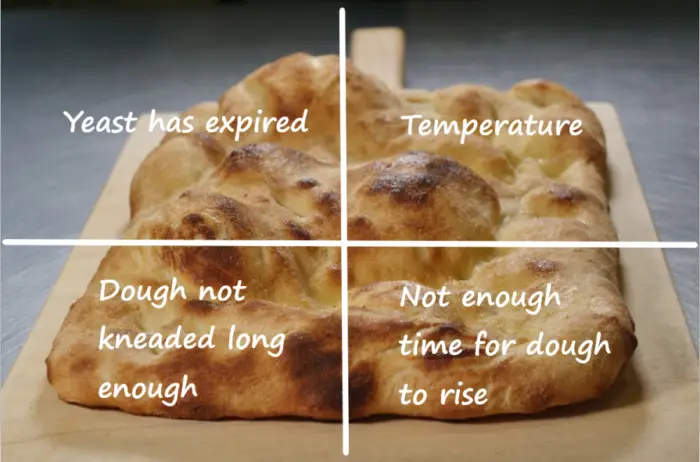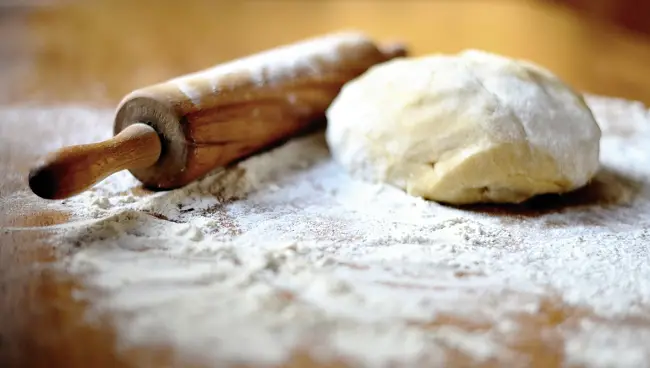Who doesn’t love the smell of a freshly baked focaccia bread. I love to bake at home, so I totally understand how frustrating it can be to wait for hours, only to find out that your focaccia dough didn’t rise. When I first started baking, I encounter this problem a lot!
There are a number of factors that can cause your focaccia not to rise. The most common one is using expired yeast. When you mix yeast with the flour and water, the yeast will consume the sugar that’s released from the flour and water mixture and release carbon dioxide in the process. This carbon dioxide is what causes the dough to rise. If you use yeast that are dead, then no carbon dioxide is released, and your dough will not rise.
Yeast is only one piece of the puzzle to getting your focaccia dough to rise. Let’s get into all the details now.
Reasons why Focaccia did not rise

Using expired yeast
As mentioned above, using expired yeast or yeast that are dead might cause the focaccia dough to not rise. Dead yeast won’t consume sugar, and thus no carbon dioxide is released, which leads to no rise.
If you are using fresh yeast, you should store the opened yeast in a air tight container, and keep them in the fridge or the freezer if you want a longer shelf life.
Personally, I like to use instant dry yeast that comes in a small 1/4 ounce packet. That way, I can just use a packet each time and not have to worry about where to store the rest of the opened yeast.
In addition, with instant yeast, you can just add them directly to the dry ingredients without first activating them. It’s just much more convenient.
Water added to the yeast is too hot
If you are using active dry yeast, where you need to activate the yeast first by adding water to it, you need to make that the water you are using is not too hot or it will kill the yeast.
The water used should be lukewarm, somewhere between 100 F -110 F. If you don’t have a thermometer to measure the exact temperature, simply put your fingers in the water to test it. You should be able to comfortably put your fingers in the water without it being too hot.
I would err to the side of the water being colder rather than hotter. You can always add more warm water to the yeast mixture if you notice that the yeast is not bubbling.
But if you added hot water to begin with, you would have killed the yeast. You can’t add cold water to save it.
Dough not kneaded long enough
Not kneading the dough long enough will cause your focaccia to be flat and dense when you bake it. This kneading process develops the gluten structure. It will make the dough more soft and elastic. This elastic structure will help trap any air that is released by during the fermentation process.
An under kneaded dough will have a dough structure that is more brittle, It cannot stretch to trap any of the gas released by the yeast, and thus cannot rise.
I usually just set a timer and knead for at least 10 mins. When done, just press a finger down on the dough, and it should spring right back to it’s shape. This is a good way to tell when the dough is ready.
Kitchen temperature is too cold
The place where you put your dough to rise need to be warm. If the temperature is too low, it will slow down the yeast activity. This doesn’t mean that the dough will not rise. However, it will increase the time needed for the dough to rise.
What I like to do, if the temperature is too cold, is to put the dough in an oven. And place a cup of hot water in the oven as well. This creates warm and adds moisture that will help the dough to rise.
Alternatively, if it is too cold, just allow a longer time for the dough to rise.
Not enough time for the dough to rise
As mentioned above, if you are leaving your dough to rise under cold temperature, then it will take longer for the dough to rise. If you can’t wait, then try the method mention above to create warmer and moist environment for the dough.
If you have time, a slow rise can help develop better flavor and structure of the dough.
Over Proofing
There was once I deviated slightly from the recommended recipe. Instead of placing the dough in the refrigerator as suggested, I let it ferment overnight at room temperature. The result is was a over proofed and flatted dough
From this, I learned the importance of using the refrigerator for dough fermentation. This cooler environment not only slows down the yeast’s activity, ensuring a controlled rise but also enhances the dough’s flavor profile.
Room temperature, on the other hand, accelerates fermentation, likely giving my dough just a 4-hour window before over proofing. Another vital insight was understanding yeast behavior. If yeast consumes all available sugars in the dough, it leads to an initial rise followed by a collapse.
Furthermore, yeast’s activity can be influenced by its age and environmental temperatures, with warmer conditions accelerating its functions.
Therefore when baking from a recipe, be sure to follow recipe guidelines closely, particularly concerning fermentation conditions, ensuring optimal flavor and rise.
Fixing Focaccia That Didn’t Rise: Practical Solutions
Sometimes, even with all the best efforts, focaccia doesn’t rise as expected. It can be disheartening to see your hard work not yield the desired fluffy and airy focaccia. But fret not; there are ways to salvage and even repurpose that dough. Here’s how to move forward:
1. Re-knead and Wait: If you suspect your dough hasn’t risen due to insufficient kneading or too cold a temperature, try kneading it again for a few minutes. Transfer it to a warm environment, perhaps using the oven method I mentioned earlier. Wait and see if it rises.
2. Add Fresh Yeast: Should you realize midway that your yeast might be expired or wasn’t activated correctly, there’s a rescue mission you can undertake. Pinch off a small dough piece, mix it with fresh yeast and lukewarm water, and then reincorporate it into the main dough. This might give your dough the boost it needs.
3. Review Yeast Storage: Prevention is always better than cure. Review how you store your yeast. An airtight container in a cool, dark place or the refrigerator can ensure longer shelf life. This reduces the chances of inactive yeast ruining your future baking endeavors.
4. Make Focaccia Crackers: Another delightful alternative for a dough that doesn’t rise as anticipated is to roll it thin and bake it to create crispy focaccia crackers. Season with some rosemary, salt, or other herbs for an extra kick.
5. Turn It Into Flatbread: Not all is lost if your focaccia doesn’t rise. Embrace the situation and repurpose the dough into delicious flatbreads. You can add toppings of choice and bake until golden. The result won’t be focaccia, but it’ll be a delicious savior of your effort.
I leave you with this simple video on what you can do with your dough:




